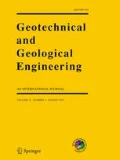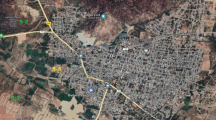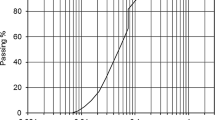Abstract
Common strategies for improvement of dispersive soils include chemical stabilization with various additives such as lime, cement, bitumen, resin, etc. Application of the mentioned materials in terms of technical and economic considerations has advantages and certain limitations. Recently, due to improvements in nano-materials production and application, use of this type of materials in different sciences especially geotechnical engineering has been considered. In this research, the effect of nanoclay on dispersivity potential of two types of clayey soils with low plasticity and high plasticity has been studied. For this purpose, first identification tests were implemented on two types of clayey soils and nanoclay, and then pinhole tests were conducted on soil samples with different amounts of nanoclay including (0, 0.25, 0.5, 1, 2 and 4% by dry weight) with respect to curing ages of 1, 3 and 7 days. Based on the results obtained from different tests, it was found that the addition of nanoclay to dispersive clayey soils could decrease their dispersivity potential considerably.






Similar content being viewed by others
References
Abbasi N, Nazifi MH (2013) Assessment and modification of Sherard chemical method for evaluation of dispersion potential of soils. J Geotech Geol Eng 31(1):337–349. doi:10.1007/s10706-012-9573-7
Acaz A (2011) The Effect of Magnesium Chloride Solution on Swell, Dispersivity and Strength Characteristics of Problematic Clay Soil. Dissertation, Eskisehir Osmangazi University
Alsharef JMA, Mohd Raihan T, Firoozi AA, Govindasamy P (2016) Potential of using nanocarbons to stabilize weak soils. Applied and Environmental Soil Science. Vol 2016, Article ID 5060531, 9 p, doi:10.1155/2016/5060531
Bell FG (1996) Lime stabilization of clay minerals and soils. Eng Geol 42(4):223–237. doi:10.1016/0013-7952(96)00028-2
Bell FG, Maud RR (1994) Dispersive soils: a review from a south African perspective. Q J Eng Geol Hydrogeol 27(3):195–210. doi:10.1144/GSL.QJEGH.1994.P3.02
Bhuvaneshwari S, Soundra B, Robinson RG, Gandhi SR (2007) Stabilization and micro structural modification of dispersive clayey soils. First International conference on soil and rock engineering, Colombo, pp 5–11
Borchardt G (1984) Stabilization of landslides: effects of various chemicals on the laboratory shear strength of an expansive soil. Special Report 155, California Department of Conservations, Division of Mines and Geology, Sacramento, CA. Stabilization Transportation Research Record, (1295), pp 45–51
Calbi-Floody M, Theng BKG, Reyes P, Mora ML (2009) Natural nanoclays: applications and future trends-a Chilean perspective. Clay Miner 44(2):161–176. doi:10.1180/claymin.2009.044.2.161
Gutierrez F, Desir G, Gutierrez M (2003) Causes of the catastrophic failure of an earth dam built on gypsiferous alluvium and dispersive clays. Environ Geol 43(7):842–851. doi:10.1007/s00254-002-0700-2
Habibi A, Ahmadi M, Pourafshary P, Ayatollahi S, Al-Wahaibi Y (2012) Reduction of fines migration by nanofluids injection: an experimental study. Soc Pet Eng 18(2):309–318. doi:10.2118/144196-PA
Huang T (2011) Clay stabilization with nano-particles. Patent application publication. Pub No. US20110000672 A1
Huang T (2012) Fines migration control at their sources in water reservoirs. Patent application publication. Pub No. US8278251 B2
Majeed ZH, Taha MR (2012) Effect of nanomaterial treatment on geotechnical properties of a Penang soil. J Asian Sci Res, 2(11): 587–592. http://econpapers.repec.org/article/asijoasrj/2012_3ap_3a587-592.htm
Majeed ZH, Taha MR (2013) A review of stabilization of soils by using nanomaterials. Aus J Basic Appl Sci 7(2): 576–581. http://ajbasweb.com/old/ajbas_february_2013.html
Majeed ZH, Taha MR, Jawad IT (2014) Stabilization of soft soil using nanomaterials. Res J Appl Sci Eng Technol 8(4):503–509. doi:10.19026/rjaset.8.999
Mohammadi M, Niazian M (2013). Investigation of nano-clay effect on geotechnical properties of Rasht clay. Int J Adv Sci Tech Res 3(3): 37–46. http://www.rspublication.com/ijst/index.html
Movahedan M, Abbasi N, Keramati M (2012) Wind erosion control of soils using polymeric materials. Eurasian J Soil Sci, 1(2): 81–86. http://dergipark.ulakbim.gov.tr/ejss/article/view/5000078238
Navrotsky A (2000) Nanomaterials in the environment, agriculture, and technology. J Nanoparticle Res 2(3):321–323. doi:10.1023/A:1010007023813
Neethu SV, Remya S (2013) Engineering behaviour of nanoclays stabilized soil. In: Proceedings of Indian Geotechnical Conference, 22–24 December, Roorkee University
Ouhadi VR, Goodarzi AR (2006) Assessment of the stability of a dispersive soil treated by alum. Eng Geol 85:91–101. doi:10.1016/j.enggeo.2005.09.042
Pham H, Nguyen QP (2014) Effect of silica nanoparticles on clay swelling and aqueous stability of nanoparticle dispersions. J Nanoparticle Res 16(1):1–11. doi:10.1007/s11051-013-2137-9
Rahimi H, Abbasi N (2007) Failure of concrete canal lining on fine sandy soils (a case study for Saveh project). J Irrig Drain ICID 57:83–92. doi:10.1002/ird.350
Rahimi H, Abbasi N, Shantia H (2011) Application of geomembrane to control piping of sandy soil under concrete canal lining (case study: Moghan irrigation project, Iran). J Irrig Drain ICID 60:330–337. doi:10.1002/ird.574
Sameni A, Pourafshary P, Ghanbarzadeh M, Ayatollahi S (2015) Effect of nanoparticles on clay swelling and migration. Egypt J Pet 24(4):429–437. doi:10.1016/j.ejpe.2015.10.006
Sherard JL, Dunnigan LP, Decker RS (1976) Identification and nature of dispersive soils. J Geotech Geoenviron Eng, 102 (Proc. Paper# 12052)
Taha MR, Taha OME (2012) Influence of nano-material on the expansive and shrinkage soil behavior. J Nanoparticle Res 14(10):1–13. doi:10.1007/s11051-012-1190-0
Turkoz M, Vural P (2013) The effects of cement and natural zeolite additives on problematic clay soils. Sci Eng Compos Mater 20(4):395–405. doi:10.1515/secm-2012-0104
Turkoz M, Savas H, Acaz A, Tosum H (2014) The effect of magnesium chloride solution on the engineering properties of clay soil with expansive and dispersive characteristics. Appl Clay Sci 101:1–9. doi:10.1016/j.clay.2014.08.007
Yilmaz I, Civelekoglu B (2009) Gypsum: an additive for stabilization of swelling clay soils. Appl Clay Sci 44:166–172. doi:10.1016/j.clay.2009.01.020
Acknowledgements
This research has been conducted using research project fund of Iranian Agricultural Engineering Research Institute (IAERI) with Grant Number of 2-14-14-94131. So the authors would like to thank the mentioned institute for their kindly assistance and funding support.
Author information
Authors and Affiliations
Corresponding author
Rights and permissions
About this article
Cite this article
Abbasi, N., Farjad, A. & Sepehri, S. The Use of Nanoclay Particles for Stabilization of Dispersive Clayey Soils. Geotech Geol Eng 36, 327–335 (2018). https://doi.org/10.1007/s10706-017-0330-9
Received:
Accepted:
Published:
Issue Date:
DOI: https://doi.org/10.1007/s10706-017-0330-9




